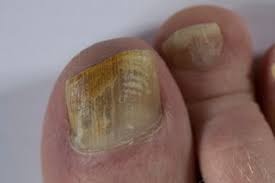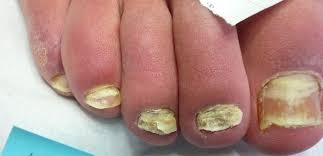

Fungal Toenail Infection
Fungal spores are present everywhere and they can infect toenails if the nails are weak or if the toenail has been damaged. Once a toenail is damaged the fungal spores can easily gain access to the toenail and the nail bed.
Fungal nail infection - onychomycosis. Note the yellow discolouration at the side of the toenail
Fungal toenail infection - note the yellow discolouration and the white flaking streak through the toenail
Once the area is infected and the fungal spores are present in the old infected nail they infect the new toenail growth. This means that the fungal spores continue to affect the nail as it grows, and the damaged part of the nail does not grow out with the growth of the nail unless the new growth is protected from the old infected nail by an antifungal agent.
The fungal spores can attack either the toenail and/or the nail bed. The damaged nail might have white and/or yellow spots, might be yellow or brown in colour and be weak and crumble easily. The nail may be thickened which can be painful. The nail often looks very unattractive and unhealthy.
At first the toenail is normally not painful. However in time the nail thickens and then walking might become uncomfortable because the thick nail can press against the top of the shoe.
Several nails might be affected or just one nail.
Why or How do you get a Fungal Nail Infection?
The fungal spores can spread from the skin (if athletes foot is present) into the nail. A recently damaged nail is more likely to become infected. Fungal spores like dark, damp places and the feet are ideal area in this respect.Who can it Affect?
- Older people
- People with medical problems such as diabetes, psoriasis, a poor immune system, poor circulation or poor general health
- People who suffer trauma to the area
- People who constantly use nail varnish
- People who have poor personal hygiene
- People who share nail cutting tools with someone who already has a fungal infection
How can you avoid Fungal Infections?
- Wash and thoroughly dry feet every day
- Wear clean socks every day
- Wear flip flops in communal areas such as sports changing rooms or swimming pool areas
- If you have Athletes foot on the skin treat it immediately
- Do not wear the same shoes every day, allow shoes time to thoroughly dry out
Treatments
Lamisil - discuss this with your GP. The treatment is not suitable for every patient.
Surgical removal of nail
Consult a chiropodist or podiatrist who will remove the nail after the area has been numbed with a local anaesthetic. This is not suitable for everyone or every nail and is considered a last resort. Complications of this procedure - damage to nail, secondary infection, re-infection.Other Topical Treatments
5% amorolfine nail lacquer - Loceryl, Curanail (Galderma)Do nothing / No treatment
The fungal infection can spread to other nails or the fungal infection which only affects part of the nail at present can eventually affect the whole nail. Depending on the type of fungal infection the nail may excessively thicken and cause pain and bacterial infection or the nail may gradually disintegrate. Can also cause further infection of the surrounding skin.

